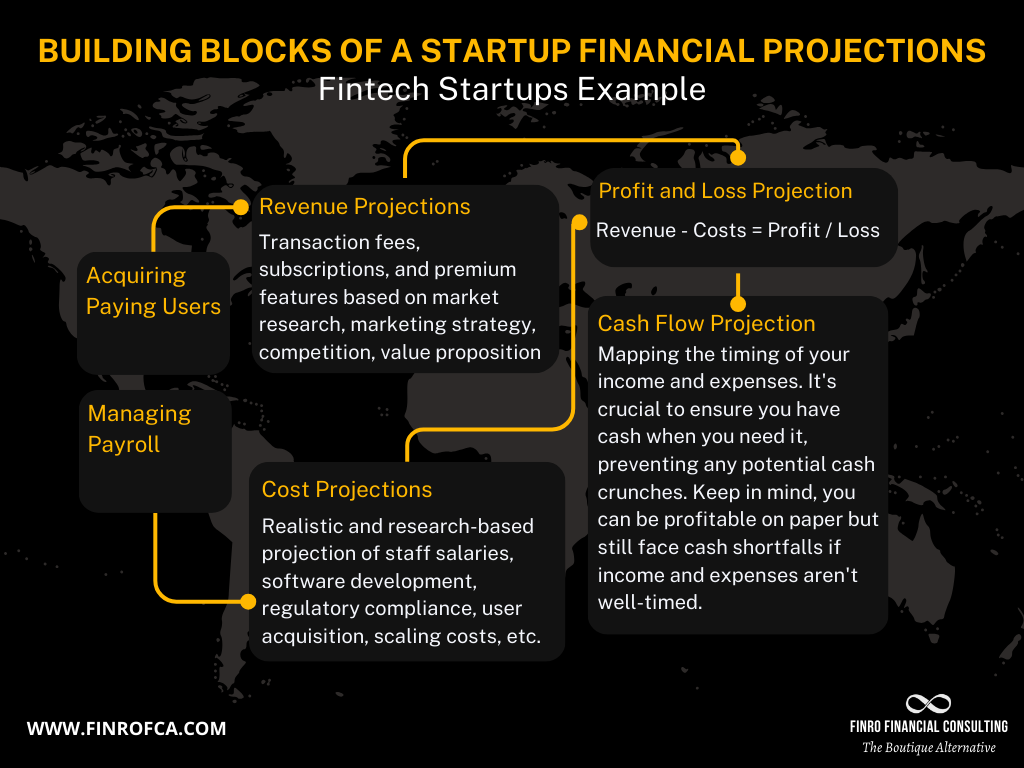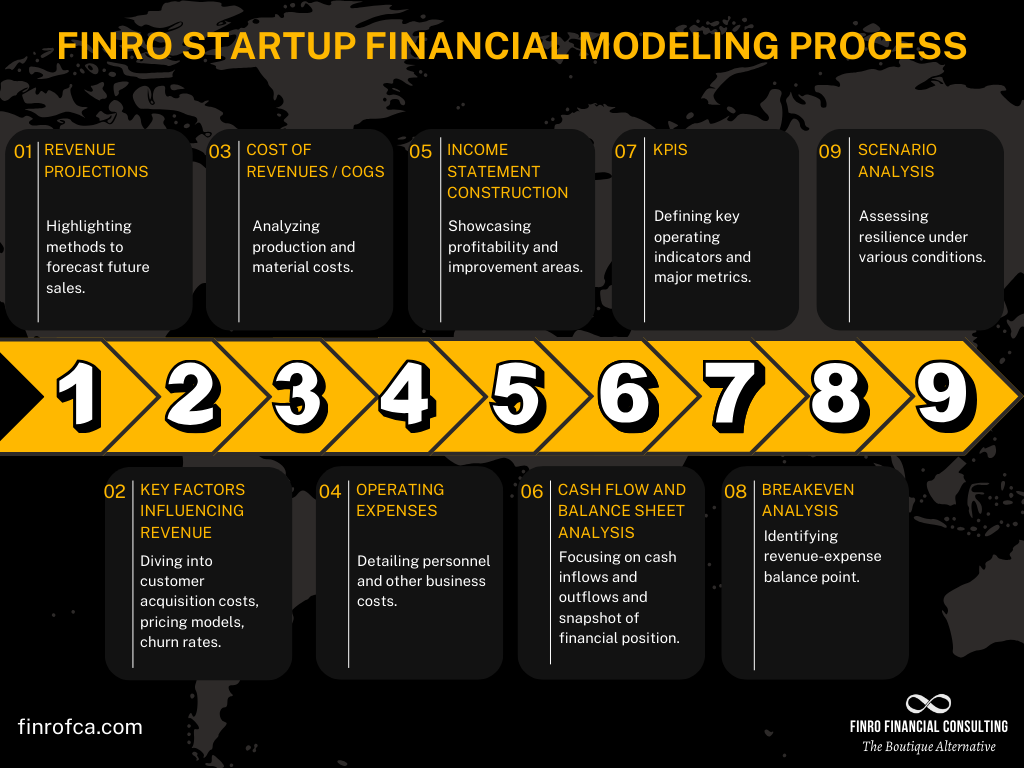Financial Modeling: Not Just for Fundraising
By Lior Ronen | Founder, Finro Financial Consulting
As a founder, you're likely familiar with the term "financial model," but knowing when to build one is crucial. Many entrepreneurs mistakenly believe that financial models are only needed when investors ask for them or during due diligence.
In reality, financial models are an essential tool for any startup from the very beginning, regardless of its stage or size.
A well-built financial model provides insights that go beyond fundraising. It helps you understand your cash flow and forecast performance and make informed decisions about every aspect of your business.
Whether you're planning how much capital you'll need to scale or determining how long your cash runway will last, a financial model becomes your guiding framework for strategic choices.
In this article, we’ll explore the benefits of financial modeling specifically for startups, from assessing funding needs to managing burn rate, and why you should start building one now—before external pressures force you to.
With the right approach, your financial model won’t just meet investor demands but will clarify your entire business journey.
A financial model is essential for startups, providing clarity on revenue projections, managing expenses, and ensuring cash flow stability. It allows founders to assess funding needs, calculate the return on investments, and communicate financial health to investors. By running various scenarios, startups can anticipate risks, plan for growth, and optimize resource allocation.
Building a model involves defining key assumptions, projecting revenue and costs, and creating profit and loss statements. Ultimately, a well-crafted financial model is a strategic tool that helps startups make informed decisions, secure funding, and ensure long-term success.
What Is a Startup Financial Model?
A startup financial model is a structured representation of a business’s financial forecasts. It integrates revenue projections, costs, cash flow, and assumptions into a cohesive tool that helps you understand your financial position and plan for the future.
For startups, this model is more than just a spreadsheet—it’s a roadmap that highlights key financial metrics and guides critical decisions.
A typical financial model for a startup includes:
Revenue projections: Estimating how much money your business will bring in, often broken down by product, service, or market.
Expenses: Listing both fixed and variable costs, such as salaries, rent, technology, and marketing.
Cash flow: Tracking when money is expected to flow in and out of the business.
Profit & loss: Summarizing expected profit margins, based on projected income and costs.
Balance sheet: Providing a snapshot of the company's financial position at a given time, including assets, liabilities, and equity.
The real value of a startup financial model lies in how it empowers founders to make informed decisions. It allows you to forecast your business's financial future, test different scenarios, and ensure that your operations align with your goals.
When you're making critical decisions—like whether to hire, expand, or raise funds—a financial model gives you the clarity you need to weigh the risks and rewards accurately.
By using data and assumptions, a startup financial model turns abstract business ideas into actionable numbers. Instead of guessing where your business stands financially, you can use your model to validate key assumptions, track progress, and ensure you’re on the right path.
Key Benefits of Building a Startup Financial Model
A well-constructed financial model isn’t just for show—it’s a powerful tool that offers practical benefits for every startup.
From securing funding to optimizing your operations, a financial model plays a crucial role in decision-making. Here are the key advantages of building one for your startup:
1. Assess Funding Needs
Understanding how much capital your business needs and when to raise it is critical for startup success.
A financial model allows you to project cash flow, estimate future expenses, and determine how much funding you’ll need to hit key milestones, such as product launches or entering new markets.
Rather than relying on rough estimates, you can develop a clear financial roadmap that guides your fundraising strategy.
2. Calculate ROI on Decisions
Startups face tough decisions, like whether to invest in marketing, hire new staff, or launch a new product line. Your financial model helps evaluate the return on investment (ROI) for each choice.
For example, if you're considering increasing your customer acquisition budget, the model can calculate the impact on revenue and profit, helping you determine if the decision is financially sound. You’ll have a clearer picture of where to focus your resources for maximum growth.
3. Update and Communicate with Investors
Regular updates to your financial model enable you to communicate your startup’s financial health effectively to investors. By tracking key performance indicators (KPIs) and actual financial results, you can show how your business is progressing against your financial plan.
Investors appreciate transparency, and a well-maintained financial model allows you to present your performance in a clear, concise way, whether during fundraising or investor meetings.
4. Explore Strategic Scenarios
A startup financial model can simulate different business scenarios, helping you understand how various factors—such as market changes or new product developments—could affect your startup.
By running multiple scenarios, from best-case to worst-case, you can plan ahead, prepare for challenges, and capitalize on opportunities. This flexibility ensures you're ready to adapt when things don't go as expected.
5. Analyze Burn Rate
For startups, managing cash flow and monitoring burn rate (the rate at which you’re spending money) is essential for survival. A financial model allows you to track your burn rate and calculate how long your cash reserves will last.
If your model shows you're burning through cash too quickly, you can use it to identify areas to cut costs and optimize spending. The goal is to extend your cash runway so your startup has more time to hit critical milestones.
Startup Financial Model vs. Corporate Financial Model
While both startups and large corporations benefit from using financial models, the approach and focus differ significantly.
Understanding these differences can help startups make the most out of their financial models and avoid common pitfalls.
Startup Financial Models: Focused on Survival and Growth
For startups, the financial model is often the lifeline that ensures survival. Cash flow is typically limited, and every dollar must be carefully allocated to fuel growth. A startup’s model is designed to:
Manage Cash Flow and Burn Rate: Startups rely heavily on tracking cash inflows and outflows, as they often operate with tight cash reserves. The financial model helps predict when a startup will need more capital and how long the current runway will last.
Attract Investors: Startups use financial models to demonstrate potential profitability, growth trajectory, and funding needs. This is often a key part of fundraising efforts, helping founders present their business in a credible and data-backed way.
Test Assumptions: Startups are constantly testing and iterating on their business models. Financial models allow them to run scenarios and assess the impact of changes, such as increasing customer acquisition costs or pivoting to a new revenue stream.
Prepare for Rapid Changes: Startups are more vulnerable to market fluctuations, operational shifts, and unexpected events. A startup financial model is built with flexibility, so it can be adjusted quickly as new data becomes available.
Corporate Financial Models: Focused on Stability and Long-Term Planning
In contrast, large corporations have more resources, established revenue streams, and access to credit, which allows for more stable and long-term financial planning. Their financial models are designed to:
Optimize Efficiency: Corporations often use financial models to find cost savings, optimize processes, and improve margins. They focus on managing efficiency across departments and identifying areas for incremental improvements.
Strategize for Growth: Large corporations use financial models to evaluate potential expansions, acquisitions, or new product lines. Their financial decisions are often based on years of historical data and deep market research.
Forecast Long-Term Performance: Unlike startups, corporations use financial models to plan for long-term stability, focusing on future profitability, managing debt, and ensuring shareholder returns. They emphasize predictable outcomes over riskier, high-growth strategies.
Monitor Financial Health: Corporations are accountable to a wider range of stakeholders, including shareholders, boards, and regulatory bodies. Financial models are used to provide comprehensive reports that ensure compliance and maintain investor confidence.
Why Startups Benefit More from Early Modeling
While both startups and corporations rely on financial models to make decisions, startups arguably benefit more from adopting financial models early on. For a startup, a well-constructed financial model is more than just a financial tool—it’s a critical asset that can shape the entire direction of the company.
Without the safety net of established revenue or large cash reserves, startups need a financial model to survive, grow, and thrive in a competitive environment.
| Aspect | Startup Financial Model | Corporate Financial Model |
|---|---|---|
| Focus | Survival and growth | Stability and long-term planning |
| Cash Management | Tight cash flow, burn rate management | Efficient use of established revenue streams |
| Investor Communication | Attract investors, demonstrate potential profitability | Ensure shareholder returns, maintain investor confidence |
| Decision-Making | Test assumptions, run multiple scenarios | Strategize for growth, expansions, and acquisitions |
| Flexibility | Built for rapid changes and adjustments | Focuses on predictable, long-term performance |
| Purpose | Secure funding, extend runway, adapt quickly | Optimize efficiency, maintain margins |
Practical Steps to Build Your Startup Financial Model
Financial modeling is a cornerstone for any startup navigating growth and sustainability. Startups face constant uncertainty, making a robust financial model not just beneficial but essential.
It offers clarity, helps optimize resources, and prepares the business for future challenges.
Here’s a step-by-step guide to creating your startup financial model:
1. Analyze the Current State
Start by gathering any available historical financial data, such as income statements, cash flow reports, or balance sheets. If you’re just starting out, you’ll rely more on assumptions about your business and the market.
Revenue history: Identify how much revenue your business has generated over time.
Expenses: Track both fixed and variable costs, such as salaries, marketing, and technology expenses.
Cash flow: Understand how cash is flowing into and out of your business.
This analysis provides the foundation for accurate projections.
2. Define Key Assumptions
The next step is to build assumptions based on market research and your own business model. These assumptions will drive your financial projections.
Revenue growth: Estimate how fast you expect revenue to grow based on market conditions and customer acquisition rates.
Customer acquisition cost (CAC): Calculate how much it will cost to acquire new customers, factoring in marketing and sales efforts.
Customer lifetime value (LTV): Estimate how much revenue you’ll earn from each customer throughout their relationship with your business.
Solid, data-backed assumptions allow for better planning and decision-making.
3. Build Revenue Projections
Revenue projections are at the heart of your financial model. For startups, they are critical in shaping business strategy and attracting investors.
Segment by product or service: Break down revenue by each offering to understand which areas are driving growth.
Pricing and sales volume: Estimate how many units or subscriptions you’ll sell and at what price point.
Ensure that your revenue forecasts account for different scenarios, such as best-case and worst-case outcomes.
4. Estimate Operating Costs
Your financial model should include detailed projections for operating costs. These include both fixed and variable expenses:
Fixed costs: Recurring costs that don’t change with production levels (e.g., rent, salaries).
Variable costs: Costs that fluctuate with business activity (e.g., materials, shipping, marketing).
Make sure to factor in potential cost increases over time as your business scales.
5. Project Cash Flow
A cash flow statement is essential for understanding your business’s liquidity. This projection will show how much cash you have on hand to cover expenses.
Cash inflows: Revenue from product sales, investments, or loans.
Cash outflows: Money spent on operating expenses, taxes, and capital expenditures.
Cash flow projections help you assess your business’s financial health and identify when you might need additional funding.
6. Create a Profit & Loss (P&L) Statement
The P&L statement gives a clear overview of expected profitability. It details your revenue, costs, and the resulting profit (or loss) over a specific period.
This is the financial document that most investors will focus on to understand the sustainability of your business model.
7. Build a Balance Sheet
Although not always a top priority for startups, the balance sheet provides a snapshot of your financial position at a given time. It includes:
Assets: What the company owns (e.g., cash, equipment, receivables).
Liabilities: What the company owes (e.g., loans, accounts payable).
Equity: The value left after liabilities are subtracted from assets.
For most early-stage startups, the balance sheet is less critical than cash flow and P&L, but it can become more important as the business grows.
8. Run Scenarios and Stress-Test Your Model
Finally, use your financial model to run different scenarios and test how your business might perform under varying conditions.
Best-case scenario: What happens if your growth outpaces expectations?
Worst-case scenario: What if your revenue falls short, or expenses increase unexpectedly?
Running these tests helps you prepare for both opportunities and risks, ensuring your startup is better equipped for whatever lies ahead.
Conclusion: Financial Models as a Roadmap for Success
Financial models are more than just spreadsheets filled with numbers; they are strategic tools that give startups the insights needed to make informed decisions, plan for growth, and secure funding.
Whether you’re a first-time founder or an experienced entrepreneur, building a financial model early on is crucial to navigating the uncertainty that every startup faces.
By following the steps outlined above, you can create a robust financial model that not only helps you track performance but also provides a clear financial roadmap for your business.
From projecting revenue to understanding your burn rate and managing cash flow, a well-constructed model empowers you to anticipate challenges, seize opportunities, and demonstrate your startup’s potential to investors.
Key takeaways include:
Clarity in Financial Decisions: A financial model simplifies complex decisions by turning assumptions and data into actionable insights.
Flexibility to Adapt: Running different scenarios ensures that your startup can adapt quickly to changes in market conditions or business performance.
Confidence in Investor Meetings: A clear and detailed financial model showcases your understanding of the business and strengthens your case when raising capital.
Startups face a volatile journey, but with a solid financial model, you can approach challenges with confidence and lay the groundwork for long-term success.
Now that you have a better understanding of how to build a financial model for your startup, it’s time to put these insights into action.
Remember, the earlier you start, the more prepared you’ll be to navigate the challenges of growth and scaling your business.
Key Takeaways
Financial Clarity: A financial model provides clear insights into your startup's revenue, expenses, and overall financial health for informed decisions.
Funding Strategy: Helps startups assess funding needs, project cash flow, and determine the best time to raise capital.
Scenario Planning: Allows startups to test various scenarios, anticipate risks, and adjust strategies based on market or business changes.
Investor Communication: A financial model enables transparent communication of financial health and performance to investors, building trust and confidence.
Resource Optimization: Optimizes resource allocation by analyzing costs, burn rate, and revenue potential, ensuring efficient use of limited startup resources.































